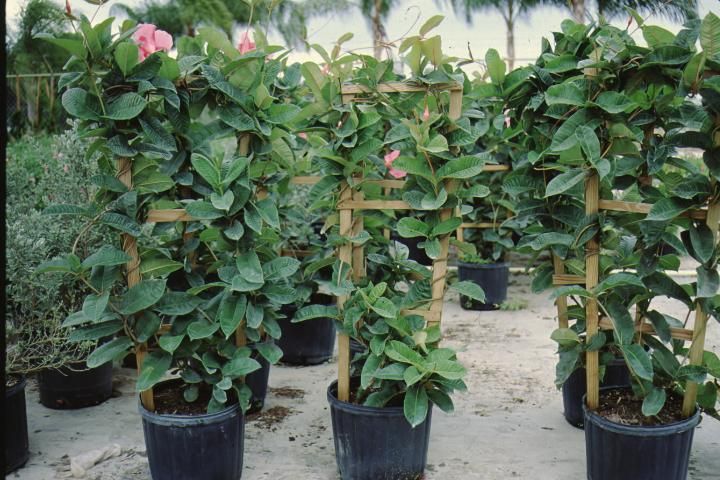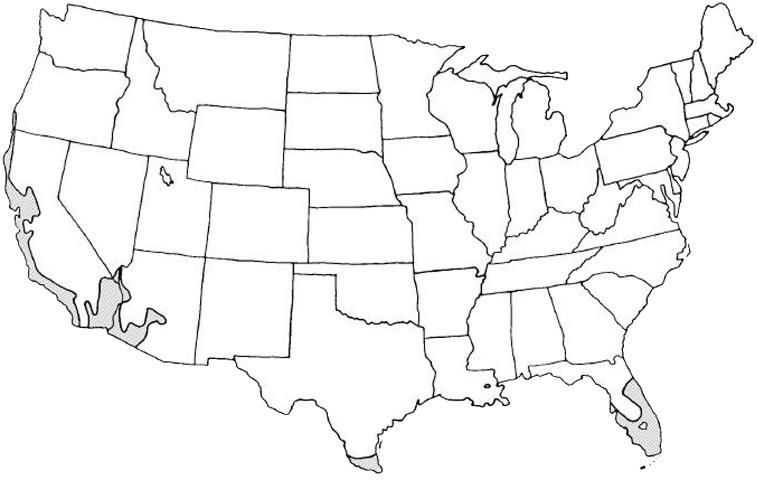Introduction
This evergreen vine or climbing shrub has 3-inch-long, funnel-shaped blooms which are reddish-purple fading to pink, giving a two-toned effect. The light green, pubescent leaves are arranged in whorls on weak, sprawling stems. While it can be allowed to rapidly cover an arbor or other support, purple allamanda also makes an attractive free-standing specimen shrub with careful pruning. Many people use it to cover the base of a mailbox or pole. Allamanda will cascade over a wall and makes a nice hanging basket. Rapid growth creates a sprawling form with individual shoots growing alone, away from the rest of the plant. Regular pinching will keep the plant in bounds, but too much pinching removes flower buds which form on new growth.

Credit: Edward F. Gilman, UF/IFAS
General Information
Scientific name: Allamanda violacea
Pronunciation: al-luh-MAN-duh vye-o-LAY-see-uh
Common name(s): purple allamanda
Family: Apocynaceae
Plant type: shrub; groundcover
USDA hardiness zones: 9B through 11 (Figure 2)
Planting month for zone 9: year-round
Planting month for zone 10 and 11: year-round
Origin: not native to North America
Invasive potential: not known to be invasive
Uses: container or above-ground planter; ground cover; cascading down a wall; hanging basket
Availability: generally available in many areas within its hardiness range

Description
Height: depends upon supporting structure
Spread: depends upon supporting structure
Plant habit: spreading
Plant density: moderate
Growth rate: moderate
Texture: coarse
Foliage
Leaf arrangement: whorled
Leaf type: simple
Leaf margin: entire
Leaf shape: elliptic (oval)
Leaf venation: brachidodrome
Leaf type and persistence: evergreen
Leaf blade length: 4 to 8 inches
Leaf color: green
Fall color: no fall color change
Fall characteristic: not showy
Flower
Flower color: lavender; purple
Flower characteristic: year-round flowering
Fruit
Fruit shape: unknown
Fruit length: unknown
Fruit cover: no fruit
Fruit color: green
Fruit characteristic: inconspicuous and not showy
Trunk and Branches
Trunk/bark/branches: not particularly showy; typically multi-trunked or clumping stems
Current year stem/twig color: green
Current year stem/twig thickness: medium
Culture
Light requirement: plant grows in full sun
Soil tolerances: occasionally wet; acidic; slightly alkaline; clay; sand; loam
Drought tolerance: moderate
Soil salt tolerance: unknown
Plant spacing: 36 to 60 inches
Other
Roots: not applicable
Winter interest: plant has winter interest due to unusual form, nice, persistent fruits, showy winter trunk, or winter flowers
Outstanding plant: plant has outstanding ornamental features and could be planted more
Pest resistance: no serious pests are normally seen on the plant
Use and Management
Flowering best in full-sun locations, purple allamanda should be planted in frost-free sheltered locations in nematode-free soil. Water plants generously until well-established. All parts of the plant are poisonous and should be used with caution in areas frequented by young children.
Propagation is by cuttings, but it is grown best when grafted on A. cathartica (yellow allamanda) cultivars 'Hendersonii' or 'Schottii.'
Design Considerations
The purple allamanda works well as a background or massing plant when grown on a trellis or fence to block undesirable views or fill gaps along walls. It can also be used to add interest to an arbor or pole. The medium-size, light green foliage of the allamanda shows well with contrasting plant features such as large leaves, coarse texture, thick stems, and dark green or burgundy color. The loose, sprawling form of the vine contrasts with neat plants such as the clumping, arching forms of grasses and other vase-shaped, small-leaved shrubs. Low-growing groundcover with a mounding or matting form will emphasize the upright form of a trained allamanda on a trellis or arbor. To create a large plant mass along a fence select other vines with a variety of flower colors, such as white, pink, or yellow to mix with the allamanda for more interest.
Pests and Diseases
No pests or diseases are of major concern except for nematodes. Purple allamanda is only occasionally bothered by scale and mites.